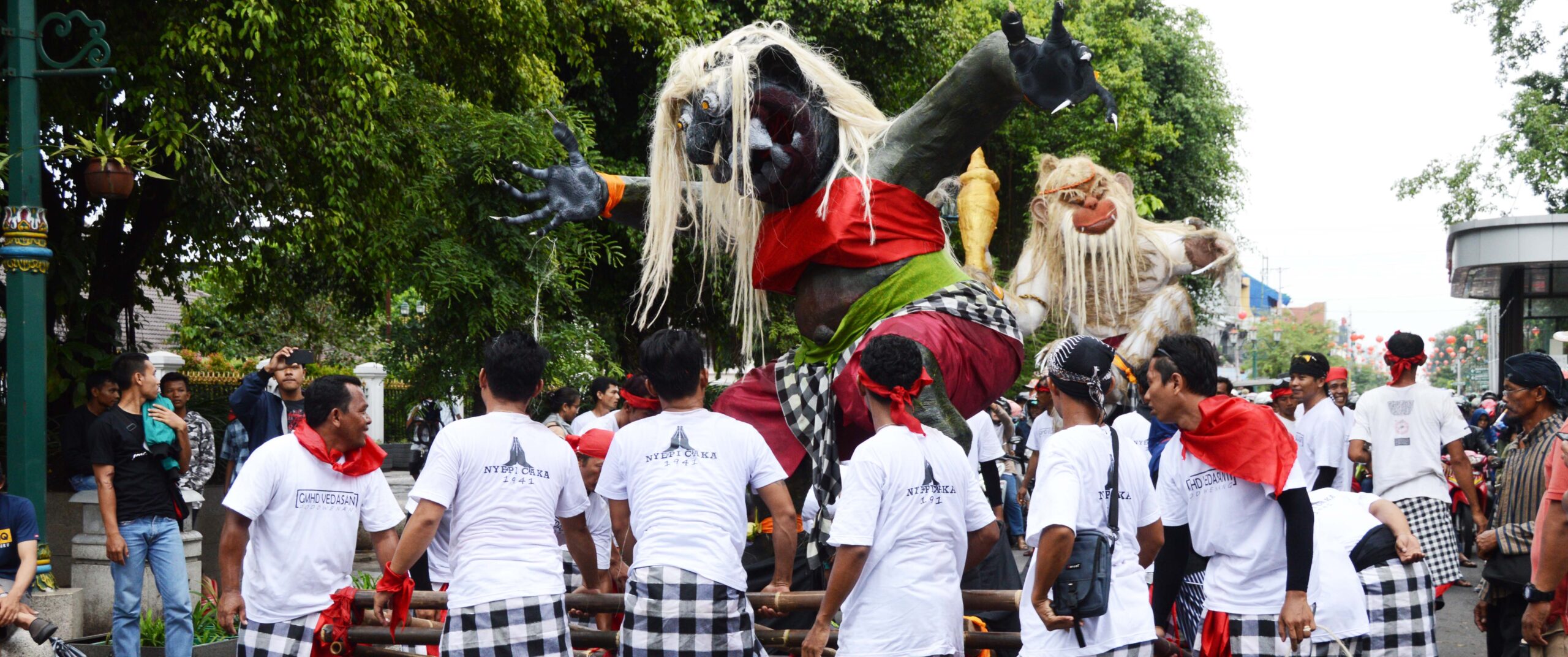
11 Mar Blog: Nyepi = On the day the Balinese are silent, should the Dutch be loud?
By Kathy Wellen.
This Sunday, 14 March 2021 is arguably the most important Balinese holiday: Nyepi or the day of silence, from the word sepi meaning quiet. It is the only Hindu holiday with the status of a national holiday in Indonesia. It is also the one day a year when Bali comes to a complete standstill. Businesses and schools are closed and the streets empty. Everyone keeps quiet from sunrise to sunrise the next day.
The holiday requires four kinds of stillness. Amati Karya entails not working. Most people have the day off from work. This includes limiting hotel staff. Certain essential workers remain present but tourists cannot check into or out of a hotel on Nyepi. The second, Amati Geni, consists of not lighting fires. This means that one cannot smoke cigarettes or cook on nyepi. Coffee and tea consumption is limited to what can be kept in thermoses and food consists of special dishes that are made in advance. A third rule is Amati Lelungan, which means not travelling. Public transportation comes to a standstill and even the airport if closed for the day. Finally, Amati Lelanguan consists of abstaining from fun and entertainment. The day is intended for mulatsarira, meaning introspection.
The goals of Nyepi are to contemplate and pray so as to let go of past mistakes, purify one’s soul, and consolidate positive energy for the future. The silence facilitates these processes, allowing for the restoration of internal peace.
Balinese New Year celebrations are not entirely devoted to contemplation, however. Nyepi is part of a larger commemoration that lasts the better part of a week. It begins three days prior to Nyepi with a purification ritual known as Melasti. Wearing mostly white, people bring sacred objects from temples to the sea or to the lake and cleanse them. This ceremony is also done in parts of eastern Java when it is known as Jalani Dhipuja. The biggest part of the New Year’s celebration is the night before Nyepi which is known as Bhuta Yajna. Offerings are made to reduce negative elements and store the balance between humanity, nature and the gods. In the evening parades are held featuring tremendous amounts of noise and giant sculptures known as ogoh-ogoh. Traditionally ogoh-ogoh are made from paper and bamboo and controlled manually. These scary figures and the accompanying noise are intended to encourage ambivalent forces to assume their more beneficent forms. The parade is followed by feasting into the night and then, at sunrise, the whole island comes to a standstill on Nyepi. The following day after people have restored their own balance and sense of purity through contemplation, the fires are relit. People visit relatives, friends and neighbors to ask each other to forgive past wrongs. Thereafter come the rituals of Dharma Shanti consisting of the recitation of scriptures and marking the ending of this sacred period.
As with all other holidays, Covid-19 has brought changes to Nyepi. Both in 2020 and in 2021 the ogoh-ogoh parade was cancelled. The silent part of the holiday, however, conforms to health advisories. Indeed, at the start of the global pandemic in 2020, Hindus in other parts of the world who celebrate the new year with more commotion drew inspiration from the Balinese.
Even before the pandemic, however, the twenty-first century witnessed changes to the festivities. For example, there are now special hotel packages for Nyepi. Guests are still expected to be quiet but escaping from home to a hotel not only reduces cultural pressures but can raise one’s prestige in certain circles. Their very existence reflects tensions between traditional Balinese culture and the capitalist world system. Tourists are not the only people making use of such deals, either. Sometimes residents of Bali view Nyepi rituals as a burden and a threat to their modern lifestyle, so they check into a hotel to avoid them.
Changes have also been made to the ogoh-ogoh. Artists take advantage of modern technologies such as sensors and electronic circuits to control the movements of the ogoh-ogoh. There has also been considerable artistic innovation as the tourist industry has stimulated the creative sector. Since the popularity of ogoh-ogoh parades started increasing in the 1980s, the production of elaborate and esthetically pleasing figures has become a huge source of pride for local communities. Another change is the prohibition of using Styrofoam because of environmental concerns.
Environmental issues need contemplation, a mulatsarira introspection to realize their gravity. We also need a show of strength and ingenuity greater than the most formidable ogoh-ogoh to spur governments, industry and the public into action. We have to act. On the other side of the planet from Bali, the Dutch milieudefensie (Friends of the Earth Netherlands) coincidently organizes a national alarm on 14 March with as much as possible noise for one minute at 15:00. A huge contrast to the stillness of Bali, but hopefully with the same effect: contemplation and thinking about what we did wrong, especially with regards to the environment. So, if you’re in the Netherlands, let’s ring an alarm at Nyepi!
For more information, see: https://milieudefensie.nl/doe-mee/klimaatalarm
Photo: Nyepi in Yogyakarta, 2019. @Fridus Steijlen.
Kathryn Wellen is a historian of Southeast Asia specialized in the early modern era. Her current research focuses on the pre-Islamic history of South Sulawesi, Indonesia.




No Comments